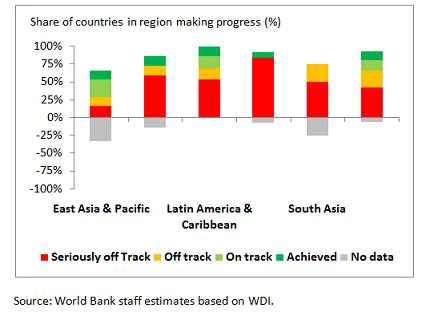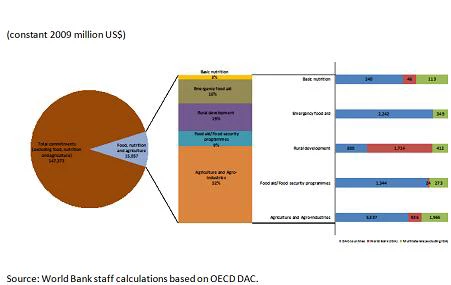The latest Global Monitoring Report analyzes the impact of recent food price spikes on the Millennium Development Goals (MDGs), paying particular attention to the negative consequences that temporary food price shocks may have on nutrition.
Nutritional outcomes are directly linked to the MDG on hunger (MDG 1.c) and indirectly to most of the remaining development targets, through its effects on cognitive skills of young children and consequently on human capital accumulation. Unfortunately, progress in fighting undernourishment is considerably lagging across nearly all developing regions (figure 1).
Figure 1. Progress toward reducing undernourishment
Surprisingly, and despite the food price spikes, Official Development Assistance (ODA) commitments from all donors to agriculture, food, and nutrition did not increase as a share of total ODA between 2000 and 2010, stagnating at approximately 10 percent, despite growing ODA flows, and widespread evidence that improved nutrition and related gains in early childhood development are key in making long-term progress in development.
Assistance for basic nutrition in 2010 represented only 3 percent of total agriculture, food, and nutrition commitments, roughly 0.2 percent of total aid commitments (figure 2). However, actual aid-financed expenditures on nutrition may be higher than reported, because other categories of aid support may also contribute to food purchase. For example, research shows that spending on social safety nets has often been used by beneficiaries to purchase more and better food. Additionally, aid delivered as fungible budget support can be used to support particular needs (which may be nutrition).
Figure 2. Composition of committed ODA and commitments by donors in year 2010
Taking a closer look at aid composition across time (table 1), we notice that the largest share of food-related commitments (above 40 percent) was directed to agriculture and agro-business at the beginning of this Millennium. Remaining aid commitments were intended for programs related to food aid and food security (30 percent), rural development (16 percent), emergency food aid (7 percent), and basic nutrition (2 percent). Ten years later, agriculture and agro-industries remain a top priority for donors (52 percent of total commitments) and short-term emergency food aid has become more relevant (16 percent). Conversely, committed resources to more structural food aid and food security programs considerably decreased, declining in constant terms from $2,640 million in 2000 to $1,644 million in 2010.
Table 1. Composition of committed ODA to nutrition, food and agriculture

Overall, this pattern illustrates a shift in the donor community to focus on alleviating the short-term impact of food crises on the most vulnerable, while at the same time providing support to programs aimed at bolstering productivity and long-term growth in agriculture, which will likely have positive implications for nutritional outcomes. In this emerging shift in composition, DAC countries have concentrated their efforts on emergency response and food aid programs, whereas international financial institutions, particularly the World Bank, have focused on rural development, agriculture, and agro-industries.
So, is the international development community effectively supporting the fight against hunger and malnutrition? What would you do?




Join the Conversation